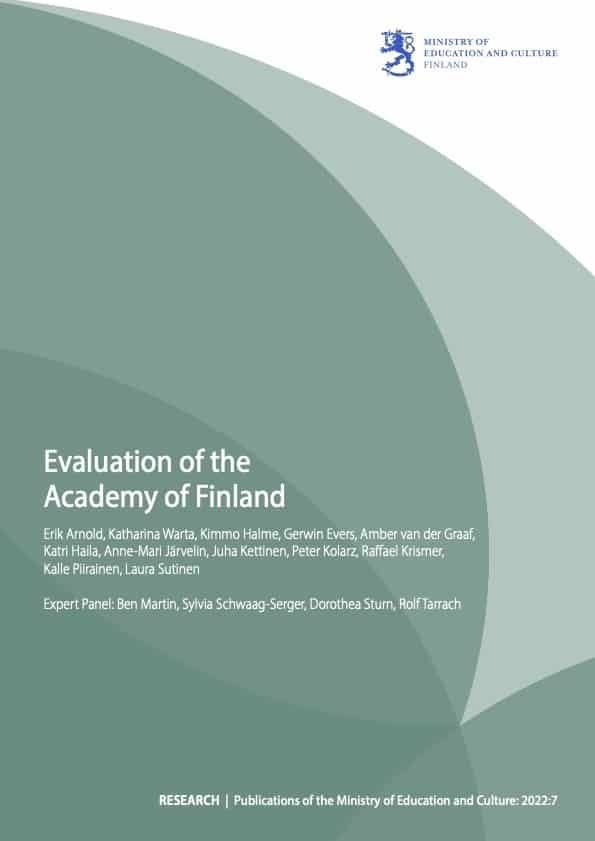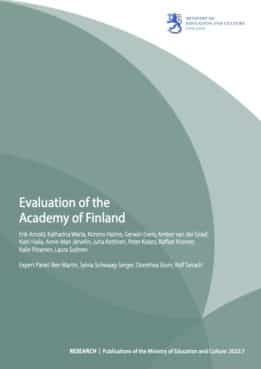Evaluation of the Academy of Finland
Publication date: 1 March 2022 | Report language: EN
This evaluation of the Academy of Finland aims to understand the performance and impact of the Academy at a turning point in the way governments internationally approach research and innovation policy. This ‘turn’ involves placing greater emphasis on addressing societal challenges in addition to promoting scientific, social, and economic development, which have been the priorities in recent decades. Following an open competition, the evaluation has been conducted by Technopolis and 4Front, supported by a panel of leading researchers and practitioners in research policy and funding.
Up to about ten years ago, Finland was admired internationally for the boldness and effectiveness of its research and higher education policy, which was credited with supporting Finland’s growth and the completion of its transition from being a resourcebased economy to become a leading industrial country. Two pillars of this approach were counter-cyclical investment in research and higher education in times of recession, and the systemic approach to policy taken by government, orchestrated through the predecessors to the current Research and Innovation Council. Based on up-to-date research and theory on the way ‘national innovation systems’ work, this systemic approach recognised the interdependence of researchers, innovators and different parts of government in generating innovation and growth, and therefore the need to make holistic research and innovation policies.
Following the 2008 financial crisis and the Nokia crisis, political consensus and commitment to research and higher education broke down. The holistic perspective was lost, gaps started to appear, notably in technology policy, and Finland began to lag behind international thinking about refocusing parts of research and innovation policy towards the societal challenges and the UN Sustainable Development Goals, as the OECD pointed out in its 2017 review of Finnish innovation policy (OECD, 2017).
In the past decade, against a background of reforms in the university and institute sectors, the Academy has taken on major new tasks. These include hosting the new Strategic Research Council, launching the PROFI programme to support research strategy development and renewal in the universities, funding the FIRI committee on research infrastructure, and setting up the Flagship programme that aims to improve the links between fundamental research and innovation in industrial ecosystems. PROFI and the Strategic Research Council were funded from cuts elsewhere in the research system. Leaving aside these transfers from other budgets, the Academy’s grant budget grew little during the period.
The Academy adopted a new strategy in 2015, focusing on quality, impact, and renewal and for the first time (in the strategy update of 2020) identifying a thematic priority – climate change – as central to its work. Its ability to implement the strategy is, however, constrained by budget and the lack of a holistic government policy that would allow it to cooperate fully with other actors. The administration budget has remained at a very low level as a percentage of the grants budget – much lower, in fact, than in other comparable organisations internationally. The Academy had to cope with the inadequacy of this budget via internal reforms and reorganisation.
Despite the budgetary constraints, the Academy’s internal processes continue to reflect good international practice. It funds research of international quality and its new tasks have been well executed. However, largely as a result of the lack of administrative budget, there has been too little critical evaluation of its instruments or reflection on their continuing relevance and the need for development. While the overall success rate for proposals to the Academy is about 20%, the success rate in some of the core bottom-up programmes is half that amount – a level internationally regarded as problematic, and which may pose a risk to the Academy’s legitimacy in the research community.
The Academy’s selection processes are gender-blind, which means that the gender imbalance among funded researchers is roughly the same as that among the applicants, suggesting that the root problem lies in the research community rather than the Academy.
Most research councils struggle with assessing interdisciplinary proposals. This is a problem because many advances in science occur at the boundaries between disciplines. However, the Academy is very friendly to interdisciplinary work, and its organisation is to a high degree consistent with the natural relationships among disciplines.
Our overall conclusion is that the Academy is working well, given the budgetary and policy constrains within which it functions, but that these constraints need to be addressed if the research and innovation system in Finland is once more to be well governed and can therefore allow the Academy to make a fuller contribution. The government needs a way to regain systemic perspective, and to decide how and to what extent it will tackle the societal challenges by thinking in terms of systemic transitions in addition to stable innovation systems. The current activities in government towards achieving the 4% target and reforming research and innovation funding are encouraging signs that this perspective can be regained, and a new dynamism injected into Finnish research and innovation policy.
This means that
- The government needs to re-establish an ‘arena’ in which it can debate research and innovation policy and governance across government and with key stakeholders. This is a precondition for holistic research and innovation governance, and for the Academy to make its full potential contribution to the national effort
- No matter which way the government decides to shape future R&I organisations and policies, it is important to maintain the Academy, and its legitimacy as the premier funder of research based on independent international based on peer review, within the system and to ensure that the research community as well as wider society feels ownership of it
- There should be substantial increases in both the Academy grant budget and in the technology programme budget of Business Finland, which are complementary means to support the desired growth in Finland’s expenditure on R&D to 4% of GDP
- A key component of the Academy’s grant budget is for infrastructure. This needs to be raised substantially in order to meet the level of need
- The Academy’s administration budget has been kept so low that it has gone beyond encouraging the Academy to be efficient and is preventing it from more radically renewing and developing its activities. It is critical that the Academy receives a substantial increase
- This will inter alia allow the Academy to support the needed further increases in Finland’s participation in international research and to review and develop its instrument portfolio
- We cannot second-guess how the government eventually decides to tackle policy for societal challenges, transitions, or missions, and there is no established international ‘best practice’ to which we can refer. However, it is clear that this must involve a high-level ‘platform’ approach to the big interventions and a more routine agency-based approach to the rest, probably based on cross-agency cooperation
- The Academy can contribute to these new policy needs d in a variety of ways, from supporting with foresight and needs analysis through running competitions aiming at developing more fundamental research aimed at supporting societal impact and making basic research contributions to crossagency programmes with societal impact goals. These should be additional to strengthening the resilience of the Academy in its major role, namely quality based funding, and quality assurance of research
- To support these roles, the Academy should become a better networked organisation across the national and international research and innovation system, engaging and cooperating with other actors outside basic research, without at the same time abandoning its roots in basic research and the research community








